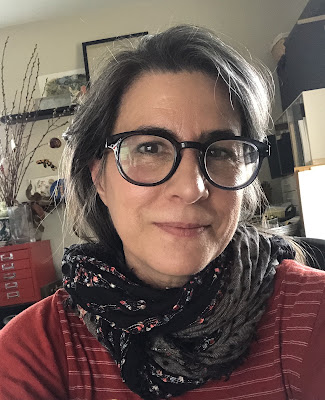Describe your illustration style in ten words or less.
Folk-art inspired graphic optimism infused with whimsical details
What items are an essential part of your creative space?
Inspiration in the form of illustrators I love, some “cue words” that mentally help me be prepared for artmaking, talismans from my travels, natural light, plants, my collection of odd and unusual things, a hot cup of tea, and a clean and ready surface (this is the hardest part!)
Do you have a favourite artistic medium?
I love, love, love gouache.
Name three artists whose work inspires you.
I’ll tackle this by narrowing it down to children’s book illustrators, and even more so by focusing on contemporary women illustrators. I can tell you that I have way more than three that inspire me, and it changes and evolves all of the time! Let’s go with Beatrice Alemagna, Carson Ellis, and Felicita Sala. Can I also mention Emily Sutton, Phoebe Wahl and Sophie Blackall? Ha ha! I could keep going…
I’ll tackle this by narrowing it down to children’s book illustrators, and even more so by focusing on contemporary women illustrators. I can tell you that I have way more than three that inspire me, and it changes and evolves all of the time! Let’s go with Beatrice Alemagna, Carson Ellis, and Felicita Sala. Can I also mention Emily Sutton, Phoebe Wahl and Sophie Blackall? Ha ha! I could keep going…
Which artistic period would you most like to visit and why?
This is very difficult to answer! I love all kinds of art and illustration. It’s like trying to pick your favourite child. But, if I had to pick a period as it relates to picture book illustration, I’d say the mid-century. It was kind of a golden age for picture book makers, especially for women. Illustrators like Virginia Lee Burton and Mary Blair, whose work is often graphic in quality with a nod to primitive folk art, resonate with me and my work. I would have loved to be a little fly on the wall in their studios.I’d have to look way back to my childhood to find my earliest inspiration. I was enthralled by the A.A. Milne Winnie the Pooh books. I wanted so badly to be able to create a world like that myself. Those stories made me want to be part of the picture book making world.
Can you share a photo of your creative workspace or part of the area where you work most often? Talk us through it.
My studio is currently in my home which is a five-story zig-zag kind of cottage. My workspace is in a small room, around a little corner on level four, where the internet is sometimes a bit rickety. It is packed with books, artwork and supplies, and is very cosy because all of the walls are covered, and every space is filled. I’ve got a drawing table under a south facing window that often holds more plants than artwork. Along one wall are bookshelves which hold just a portion of my picture book and art book collection, the rest of my collection is on level two. On some walls are shelves that hold a tumble and jumble of inspirational art and things.
My base workspace is a u-shaped work surface where I have my computers, lots of traditional art supplies and my scanner. In this area I’ve got a bulletin board where I keep schedules (I also have electronic versions, but I like to see printouts too) inspirational quotes and some of my own personal goals. All around the room are special trinkets and talismans that make me feel connected to people and places.
I love the whole process really. Generating ideas is the most exciting part. But after the idea is hatched, when you are in the thick of the artmaking, that is the most relaxing and rewarding part. So, I guess that is my most favourite part.
What advice would you give to an aspiring illustrator?
New illustrators are always desperate to find their mark-making “style” or what some would call “their voice”. There are really only a couple of ways to do that. One is to make a lot of art, experimenting with techniques and tools. The other is to identify what makes you different from others as a person. What is your heritage and your upbringing? What are the experiences you’ve had, and the places you’ve been? What is important to you and what do you believe in and value? Understanding yourself and what makes you unique, and connecting your art to those things, will make your work unique. It’s the secret sauce.
New illustrators are always desperate to find their mark-making “style” or what some would call “their voice”. There are really only a couple of ways to do that. One is to make a lot of art, experimenting with techniques and tools. The other is to identify what makes you different from others as a person. What is your heritage and your upbringing? What are the experiences you’ve had, and the places you’ve been? What is important to you and what do you believe in and value? Understanding yourself and what makes you unique, and connecting your art to those things, will make your work unique. It’s the secret sauce.
Cynthia grew up in a tiny historic village in rural Virginia, surrounded by animals, gardens, and a large extended family—which provided her with a love of history, family, nature, and folklore—themes that find their way into much of her work. She began her professional illustration career in 2019 after living many other lives. Today, she resides in Virginia just outside of Washington, D.C.










